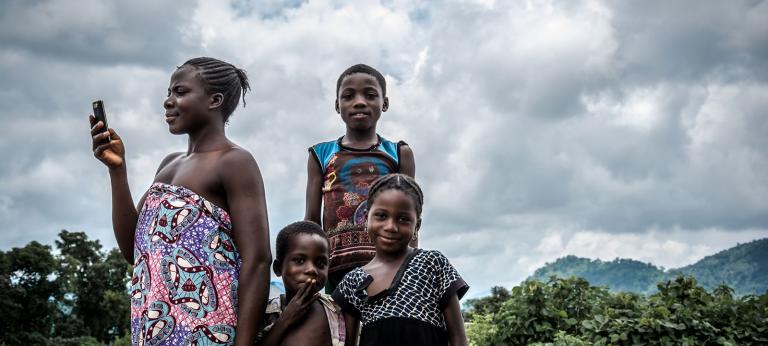&
&
Adaptation
The context
Farmers are facing unprecedented interlinked global shocks and challenges that threaten the gains in global food security and poverty reduction in recent years. Since most agriculture is rainfed in developing countries, climate change directly impacts agriculture by increasing temperatures and changing when and how much it rains. Most of the seeds, animals, and farming practices providing the world’s food are less productive as the climate changes, having been developed for past climates. Hence, farming and food systems need to be transformed across the globe to build resilience to these climate impacts and meet the increasing demand for food by growing populations and cities.
This need is most acute in developing countries, affecting at least 2.4 billion people on 19 million km2 of agricultural land. Reconfiguring the world’s agriculture and enhancing food and nutritional security will be challenging, but it offers opportunities for enhancing climate resilience, reducing agricultural CO2 emissions (10-12 per cent of global total, IPCC), and providing a suite of co-benefits, including: reducing the degradation of ecosystems and land and water resources; reducing biodiversity loss; creating millions of new jobs by improving value chains in agriculture; improving nutrition; reducing waste; and providing new opportunities for marginalized groups including women, youth, those living in poverty and indigenous peoples to manage resources and access services, assets, knowledge and skills.
The key challenge faced in the agricultural and food security sector is the need to increase both the quantity and quality of food production, while reducing the sector’s environmental footprint, within the context of a changing climate. The cost of adaptation in agriculture alone will be more than USD100 billion per year. Key barriers include:
- Lack of integrated agricultural development planning and capacities that consider maladaptation risks and investment needs across the agricultural sector, climate information services and supply chains.
- Lack of adequate finance to develop a pipeline of commercially viable climate-resilient projects and programmes.
- Limited investment in innovative farming practices, agricultural technologies and business models to incentivize farmers to adapt to a changing climate while maintaining high quality agricultural production.
- Limited investment in new ICT services to provide farmers with relevant and timely climate and market information.
- Lack of access to affordable finance for farmers and local agri-businesses to invest in low-emission agricultural practices and sustainable food systems.
- Inadequate levels of public and private finance to invest in commercially viable climate-resilient projects and programmes at scale.
- Limited sharing of experiences and knowledge to scale up and replicate successful practices.
GCF's unique role
A transformation towards resilient and low-emissions agricultural and food systems can be achieved through three paradigm- shifting investment pathways: 1) Promoting resilient agriculture; 2) Facilitating climate informed advisory and risk management services; and 3) Reconfiguring food systems.
GCF offers a four-pronged approach to support developing countries drive implementation across these 3 pathways :
- Transformational planning and programming: GCF aims to strengthen the capacity of developing countries to undertake integrated agricultural development planning, mitigating risks of mal-adaptation and maximizing joint adaptation-mitigation synergies and co-benefits; to put in place enabling community-responsive policy frameworks; to undertake policy changes such as subsidy reforms in an inclusive manner; to identify and design transformational climate investments in the agricultural and food security sector to realize the countries’ NDCs and National Adaptation Plans (NAPs); to support extension services, insurance and social protection programmes, and co-design delivery systems to meet users’ needs. Such actions prepare the country for GCF investment and build its capacity for seeking other funding sources.
- Catalyzing climate innovation: GCF invests in innovative, high-potential business models, technologies, practices, and financing instruments with potential to scale. It is important to leverage emerging digital technologies and strengthen national capacities to empower farmers and agribusinesses to provide climate information services in new ways; and to support countries develop innovative financing instruments, such as weather index insurances. About three quarters of GCF agriculture projects are currently funded with grants for climate innovation, primarily landscape-level projects in land and water management, resilient practices, irrigation, capacity building, climate information, livelihoods diversification, and market access.
- Mobilizing finance at scale: This includes a range of blended financing instruments and innovative structuring to de-risk and catalyze public and private finance at scale. For example, GCF is leveraging guarantees and concessional finance to scale up successful, high-potential, climate-compatible investments by public and private partners; creating funds to support input suppliers, SMEs and cooperatives; and incentivizing biodiversity conservation through payments for ecosystem services (PES). It also includes supporting public-private partnerships to stimulate resilient supply chains and mobilizing larger institutional sources of capital through aggregation and securitization via capital markets.
- Creating coalitions and knowledge to scale up success: GCF supports the disseminate and uptake of best practices, methodologies, and standards for transformational climate investment to replicate and scale up action, and leverages partnerships and coalitions to extend successful practices into new areas, targeting investment towards high-impact actions that are most closely suited to different agro-ecological and socio-economic contexts.
Resources

Thematic brief: Agriculture and food security
26 Oct 2021
Farmers are facing unprecedented interlinked global shocks and challenges that threaten the gains in global food security and poverty reduction in recent years. Since most agriculture is rainfed in developing countries, climate change directly impacts agriculture by increasing temperatures and changing when and how much it rains. Most of the seeds, animals, and farming practices providing the world’s food are less productive as the climate changes, having been developed for past climates.

SAP Technical Guidelines: Water security
21 Feb 2023
This publication provides technical guidance for the preparation of simplified approval process (SAP) proposals for water security projects. GCF defines the water sector as encompassing surface freshwater resources and groundwater, but not oceans. Since the water sector is interlinked with several other sectors, such as agriculture and ecosystems, it is necessary to delineate its scope.
Case studies

Acumen Resilient Agriculture Fund (multi-country)
Agriculture is a major industry in the target countries in Africa, and up to 80 per cent of farmland is managed by smallholder farmers who are highly vulnerable to the impacts of climate change. The Acumen Resilient Agriculture Fund (ARAF) supports pioneering and early-growth innovative agribusinesses that enhance the climate resilience of smallholder farmers, shifting the pattern of investment in climate change adaptation activities in Africa from grants to a long-term capital approach. It will support innovative private social entrepreneurs in micro-, small, and medium-sized enterprises (MSMEs) by providing aggregator and digital platform and innovative financial services to smallholder farmers. The project has an estimated lifespan of 12 years. See project details >

Transforming the Indus Basin with climate resilient agriculture and water management (Pakistan)
Pakistan’s agricultural water supply is vulnerable due to its arid to semi-arid climate, as well as its high dependency on a single river system with snow and glacial meltwater. This project will develop the country’s capacity to use the information it needs to adapt to the impacts of climate change by putting in place state-of-the art technology for climate services. It will build farmers’ climate resilience through skills, knowledge and technology enhancement activities. It will also create a wider enabling environment for continuous adaptation. This project has an estimated lifespan of 20 years. See project details >

































